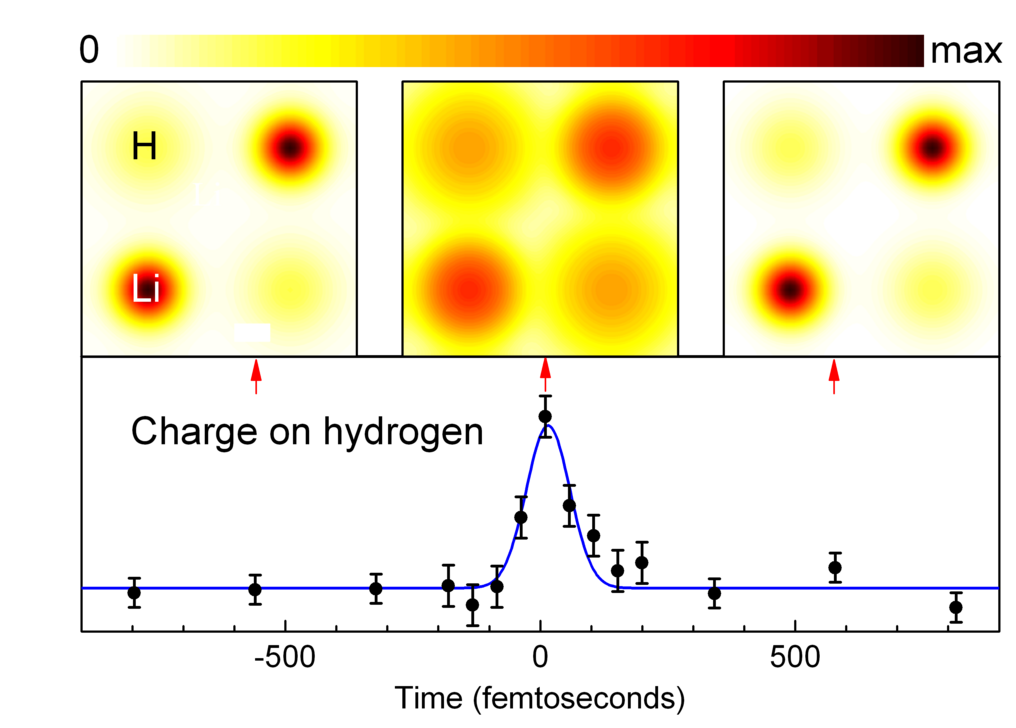An ionic crystal is a regular arrangement of positively and negatively charged ions in space. A prototype material is the common salt sodium chloride (NaCl) with cube-shaped unit cells. This cube contains positively charged Na+ ions that lack an electron that was released into a negatively charged Cl ion (Figure 1). Another material with common salt structure is lithium hydride (LiH) consisting of Li and H atoms. In contrast to the ionic salt Na+Cl-, the charges in lithium hydride are calculated as Li0.5+H0.5-, a kind of mixed variant between the ionic case Li+H- and the covalently bound case Li0+H0- in which the atoms stay neutral. The special behavior of LiH has its origin in the strong electrical forces between all the charged particles in the crystal. The spatial arrangement of the electrons is determined by the minimization of the total electrical energy. When an external electric field is applied, the electrons are set in motion, which is also strongly influenced by the spatial correlations of all electrons. Although electron correlations are a topic of many theoretical publications, direct experimental insights into this important topic have so far been sparse.
How to move electrons along chemical bonds

Fig. 1 Crystals with saline structure. Upper crystal: common salt (NaCl) with blue spheres for the Na+ ions and green spheres for the Cl ions. Lower crystal: lithium hydride (LiH) with small blue spheres for the Li0.5+ ions and white sphere for the H0.5 ions. The gray shaded plane shows the section plane for the electron density maps in Figure 2.
For the first time, the team from Project 3.3 was able to observe such electron correlations directly in space and time by recording the electron movement in the form of a time-dependent map of the electron distribution. In the experiments, the electrons are set in motion by a very strong electric field, which is applied to the LiH crystal only in a very short time interval of 50 fs (1 fs = 10-15 s) by means of an optical pulse of light. The altered electron distribution is measured by means of 100 fs X-ray flashes scattered on the sample. In the current issue of the journal Physical Review Letters [111, 217401 (2013)], Vincent Juvé, Marcel Holtz, Flavio Zamponi, Michael Wörner, present Thomas Elsässer and Andreas Borg shouldered time-dependent electron density maps showing an extremely fast shift of electronic charge from the Li0.5+ to the H0.5 ions over a distance of 0.2 nanometers (1 nm = 1 billion meters). This completely unexpected behavior means that the material becomes more ionic upon application of an electric field. This observation is in contrast to the usual behavior of ionic systems, such as LiBH4 or NaBH4.

Fig. 2 LiH electron density maps in the gray-shaded plane of Figure 1 for times before (left field), while (middle field) and after (right field) the interaction with the strong electric field of the optical pulse of light. The contour images show the electron density (charge per volume). The electric field moves electronic charge from the Li0.5+ to the H0.5 ions, making the material more ionic.
Since the electric field of the optical pulse changes its direction every 1.3 fs, the electron is drawn back and forth between two ions at about one percent of the speed of light (c = 300,000 km / s). After the optical pulse, the electron returns and the original electron distribution is restored. Qualitatively, the unexpected electron movement can be explained as follows: The electric field accelerates the electrons in such a way that they are distributed more uniformly over the unit cell. Since Li originally has more electrons, this redistribution leads to the loss of electrons. Due to the very small number of electrons in LiH, all electrons contribute to this effect, so that the electron distribution is very sensitive to correlation effects, which confirm theoretical calculations. The manipulation of electron distributions by means of strong electric fields is an interesting possibility to control the matrix properties on very short time scales, which could find technical application, for example, in ultrafast electrical switches.
Search publications of MBI
Publications since 2025